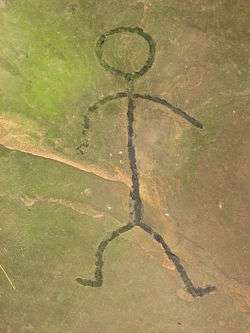Stick figure
A stick figure is a very simple drawing of a person or animal, composed of a few lines, curves, and dots. In a stick figure, the head is represented by a circle, sometimes embellished with details such as eyes, mouth or hair. The arms, legs and torso are usually represented by straight lines. Details such as hands, feet and a neck may be present or absent, and the simpler stick figures often display an ambiguous emotional expression or disproportionate limbs.

Graffiti of stick figures are found throughout history, often scratched with a sharp object on hard surfaces such as stone or concrete walls. Stick figures are often used in sketches for film storyboarding.
History
The stick figure's earliest roots are in prehistoric art. Tens of thousands of years later, writing systems that use images for words or morphemes—e.g. logographies such as Egyptian and Chinese—started simplifying people and other objects to be used as linguistic symbols.
There is also a modern history that traces at least in part from Rudolf Modley's extending the use of figures from Isotype for commercial use. The first international use of stick figures is in the 1964 Summer Olympics in Tokyo. Pictograms created by Japanese designers Masaru Katzumie and Yoshiro Yamashita formed the basis of future pictograms.[1] In 1972, Otl Aicher developed the round ended, geometric grid based stick figures used on the signage, printed materials, and television for the 1972 Summer Olympics in Munich.[2][3] Drawing on those and many other similar symbol sets in use at the time, in 1974 and 1979 AIGA (commissioned by the U.S. Department of Transportation) developed the DOT pictograms—50 public domain symbols for use at transportation hubs, large events, and other contexts in which people would know a wide variety of different languages. These, or symbols derived from them, are used widely through much of the world today.
 A stick figure at the prehistoric Leo Petroglyph in the United States.
A stick figure at the prehistoric Leo Petroglyph in the United States. The AIGA symbol for drinking fountain.
The AIGA symbol for drinking fountain.- One of Otl Aicher's stick figure signs at the 1972 Munich Olympics. Aicher's ubiquitous pictograms form the template for many subsequent designs.
In media

- The London-based graffiti artist Stik uses stick figures in his work.
- Comics such as The Order of the Stick, Nothing But Stick Figures, Wait But Why, and xkcd depict characters in a stick figure style.
- Stick figures are often used in animations made with Adobe Animate. Such figures are easy to draw and can be traditionally animated much more quickly than full drawings. Some online cartoon series, such as Xiao Xiao, have been made using the software.
- Many other stick figure animation suites exist, which allow the user to create an animation frame-by-frame, or by extrapolating the intermediate frames between a start and endpoint. Animations can be exported in various formats and shared online. Stick figure animation software includes Pivot Stickfigure Animator.
- One of Animusic's most well known animations is named "Stick Figures", the centerpiece being a robotic bass guitar with arms reminiscent to that of a stick figure, playing itself with a "tapping" method reminiscent of a Chapman Stick.
References
- "Visual Design". Official Report of the 1972 Olympic Games, volume 1. Munich: Pro Sport. 1974. p. 272. OCLC 1076250303. Retrieved June 21, 2020.
- "Otl Aicher pictograms and the 1972 Olympic Games". Otl Aicher pictograms. Retrieved June 21, 2020.
- "Otl Aicher". Architectuul. Retrieved June 21, 2020.
External links
| Wikimedia Commons has media related to Stick figures. |